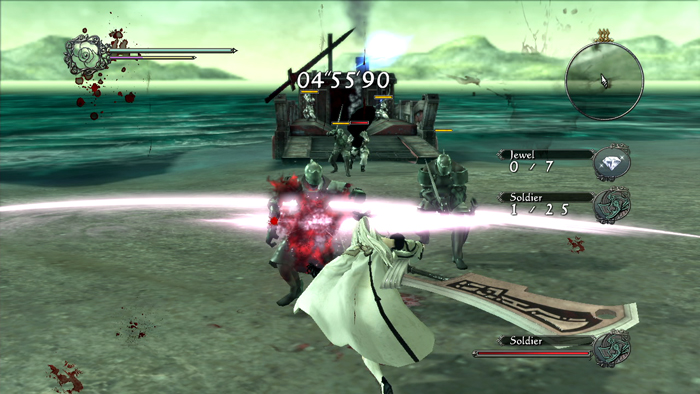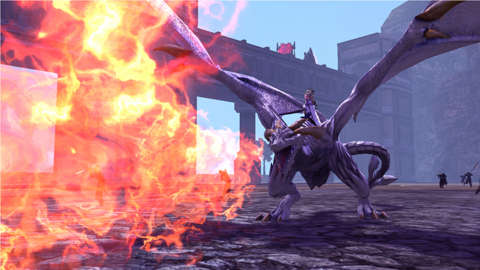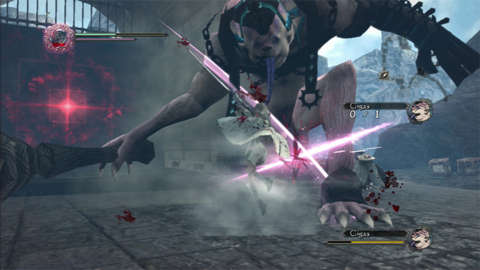From a traditional perspective, Drakengard 3 is not what you would normally consider a good game. It's severely visually outclassed, it has myriad bugs and issues, and the gameplay is fair at best and tedious at worst. The original game, released a decade ago on the PlayStation 2, was much the same way. But what made that game memorable was its distinctly dark and twisted story in a world filled with horrible happenings and broken, deplorable characters. It was a train wreck, horrifying to look at and experience, but it kept you playing to see just how much more awful things could get. Nothing ended well for anyone involved, including the player, but it was fascinating regardless.
And that's precisely what Drakengard 3 is: utterly fascinating.
The game takes place in a miserable fantasy world where goddess-like beings called "intoners" rule the land and keep the masses appeased with their otherworldly songs. That peace is transformed into a bloody mess when the oldest of the intoners, Zero, decides that her five sisters (all named after numbers) need to die for reasons initially unclear. Zero's attack on her sisters ends in abject failure and the death of her dragon companion, but a year and a reconstructed body later, she is ready and rarin' to kill her estranged siblings again. To aid her this time around, she has Mikhail, the reincarnation of her previous dragon, by her side. Unfortunately, a wise old elder dragon this creature is definitely not; Mikhail is an inept pacifist who calls for nonviolent resolution as he whines about his bodily functions like a first grader.

Drakengard 3 is a hack-and-slash action game. Zero runs through mostly linear fields, defeating foes with combos and special moves derived from four different weapon types (swords, spears, chakrams, and combat bracers). She can guard, dodge, and cancel her skills into defensive maneuvers as necessary. As she defeats foes, a flower-shaped blood meter fills up, and once it reaches a certain threshold, Zero can enter the incredibly powerful and near invincible intoner mode for a very limited time. Unlike in other games of this sort, the blood meter doesn't have to be full in order for you to enter intoner mode, though its level does limit the amount of time intoner mode lasts. This adds a bit of strategy to fighting--should you use intoner mode for short bursts of carnage, or save it for bigger, powerful foes?--but overall, nothing about combat is particularly noteworthy. It's certainly functional, and there's definitely a satisfaction to be had when going to town on a bunch of dimwitted soldiers and their giant monster companions, but it's a far cry from the likes of Bayonetta.
Every so often, however, Zero mounts her lovably stupid steed and uses Mikhail for combat. Mikhail's sequences are either Panzer Dragoon-style rail shooter sequences (though not nearly as well made as in that franchise) or free-roaming sequences where Mikhail can fight foes both in the air and on land. The controls in this mode take some getting used to, and many of these stages and arenas aren't ideal for large, bumbling winged reptiles to be battling in. Still, it's a welcome, if not always particularly well-designed, break from stabbing troops directly.

In fact, "well-designed" doesn't apply to most of Drakengard 3. The game is developed by Access Games, the studio behind the cult hit Deadly Premonition, and shades of that game's distinct clumsiness abound in Drakengard 3. Enemy models are frequently recycled, and, in some cases, they don't stand on uneven ground properly, leaving one, two, or even more feet just floating in midair. Textures are frequently so low-res that the game looks like a poor HD upscale of a PS2 version that never existed. Enemies and AI partners frequently get stuck trying to run past walls or off ledges. The combat camera appears to hate you and everything you stand for, going into bizarre angles and focusing on barriers to the action out of spite. The frame rate fluctuates constantly, sinking to single-digit levels if a bunch of projectile-hurling enemies are in the area. I encountered at least two occasions when the game forgot to reverse Zero's controls after shifting the camera 180 degrees.
Yes, Drakengard 3 is a technical mess. But, in a weird way, that's part of its charm. If you're familiar with the previous games of creator Yoko Taro--the original Drakengard and Nier--then you're probably coming in expecting messy gameplay. You're not here to kill a thousand grunts; you're here for a weird, fascinating, and much bigger experience. And, to that end, Drakengard 3 is amazing.
The driving force for everything in Drakengard 3 is the main character, Zero. Zero is a nasty, nasty woman, mocking everyone within sight and berating Mikhail for his childish naivete at every opportunity. Yet, in a strange way, she becomes incredibly sympathetic. Her voiced reactions to the ridiculous plot twists, outlandish characters, and irritating gaming cliches frequently mirrored my own. It felt as though I were reacting through her involuntarily to the horrifying happenings of this sick, sad world. I actually felt like I related to her as the game progressed, which is not something I typically feel for antihero characters.

Part of the reason Zero's anger didn't turn me off right away, though, was that every human in Drakengard 3 is a horrible person. Zero's sisters are selfish and domineering, with personality traits that are immediately off-putting. Their disciples, whom Zero can recruit as non-player character helpers after defeating them, aren't much better, individually representing the traits of sadism, masochism, sexual hedonism, and narcissism. Their dialogue with Zero throughout the levels, and their interactions with her, are frequently amusing and well written, even if the same jokes get recycled too often. (I commend the localization team for its ability to come up with numerous entertaining penis euphemisms.)
The first playthrough of the game feels like a distinctly black parody of game story and design tropes, filled with awkward character interactions, bizarre non sequiturs, and a general disdain for everything Zero is forced to go through when all she really wants to do is kill her sisters and be done with it. There are odd little digs at things like Japanese character design, media censorship, and otaku culture. It concludes with a bizarre twist that seems disappointing at first, but shifts the story in an entirely different direction.
Much like Drakengard and Nier, this is a game where the multiple endings are a near essential part of the whole experience. The humor is played down as the game steers you along its alternate paths. On the way, it comments on game structure and the role of the player as both active participant and passive observer, and goes deeper into individual character backgrounds and relationships. It never stops feeling oppressive and unpleasant, but that's part of what makes it so interesting--so much so that when the game asks you to grind to get every weapon to open the path to the final ending (though, thankfully, not the downloadable weapons--that's too cruel even for Drakengard), you feel not just obligated to do it; you want to do it. It's laborious and unpleasant, and somehow Drakengard transforms it into something you willingly want to do all while knowing it probably won't be enjoyable in a typical gaming sense.

Drakengard 3 is subversive in that way. I love how it has made me think about violence and what exactly makes characters sympathetic even when they're terrible. I love that the game portrays its female characters as assertive beings that desire and need sex on their own terms, instead of as sexual material doled out in-game as "rewards" for player performance. (In fact, the only time Zero discusses sex with her disciples is to either tell them to shut up with their innuendo or berate them for their poor performance in the sack.) I love how the only voice of human sanity is a nonhuman. I love how I can step away and think about how the concepts introduced in the alternate ending paths symbolize abstract concepts of gaming. I love Drakengard 3, warts and all. In fact, I think the warts might be part of what makes the game so appealing. It's a heavily flawed game, set in an ugly world and filled with despicable people. And yet, somehow it's beautiful.